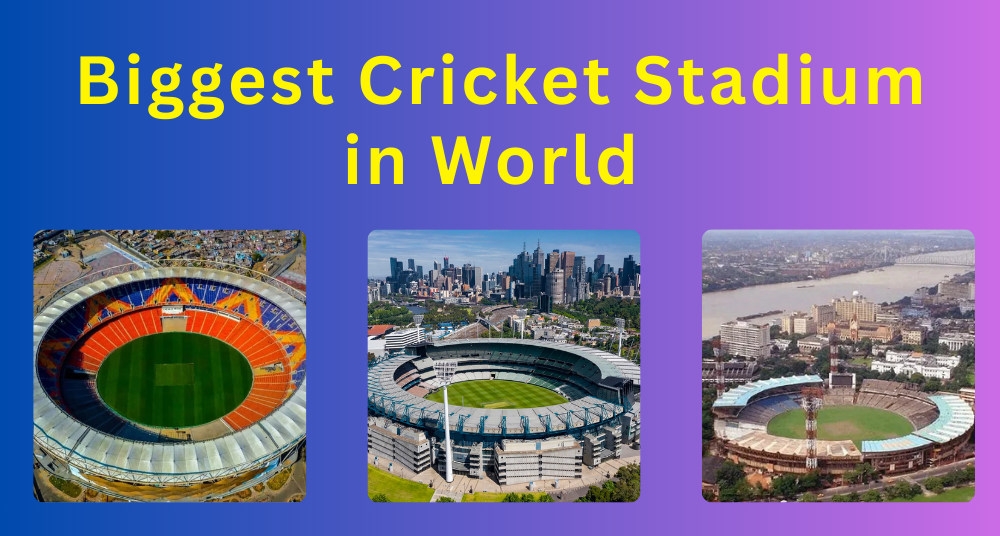Cricket is much more than a game—it’s a global passion that unites millions of fans across continents. The epic battles played on the field are powered by roaring crowds. Stadiums are the heart of these sporting spectacles—they are not just venues, but grand stages where history unfolds.
These colossal arenas, ranging from iconic historic grounds to architectural marvels, are built to host massive audiences. Their sheer scale and design contribute to the energy, drama, and grandeur of cricket.
In this article, we’ll explore the top 10 largest cricket stadiums in the world by seating capacity, uncover their unique features, and celebrate the mix of tradition, technology, and sheer scale that makes them extraordinary.
Criteria for Ranking the Biggest Cricket Stadium in World
We rank the largest cricket stadiums primarily by seating capacity, as this directly reflects their ability to host grand-scale matches and large audiences.
Additional criteria include:
- Ownership and management: Who operates and maintains the ground.
- Year of establishment or renovation: Indicators of legacy and modern infrastructure.
- Technological amenities: Unique features like lighting systems, practice facilities, and player conveniences.
- Historical and cultural significance: Stadiums with a storied past or iconic status.
10 Biggest Cricket Stadium in World
Narendra Modi Stadium – Ahmedabad, India
The Narendra Modi Stadium in Ahmedabad, India, holds the record as the world’s largest cricket stadium with a capacity of 132,000 spectators. Originally built in 1982 and completely reconstructed in 2020, it features state-of-the-art facilities like four dressing rooms, modern LED lighting, and multiple practice pitches. It has hosted the 2023 ICC Cricket World Cup Final and several Indian Premier League matches, making it a premier venue for both international and domestic cricket.
| Feature | Details |
| Capacity | 132,000 (largest cricket ground globally) |
| Highlights | Four dressing rooms, 11 center pitches, two practice grounds; modern, column-free design with stadium lighting integrated into LED ring |
| Opened | Rebuilt and inaugurated in 2020 |
Melbourne Cricket Ground (MCG) – Melbourne, Australia
The Melbourne Cricket Ground (MCG), often called “The G,” is one of the most iconic cricket venues in the world with a seating capacity of around 100,024. Built in 1853, it has hosted historic events such as the first-ever Test match in 1877, World Cup finals, and the famous Boxing Day Test matches. Its modern architecture and rich legacy make it a landmark for cricket fans worldwide.
| Feature | Details |
| Capacity | 100,024 (95,000 seating + 5,000 standing) |
| Highlights | Historic venue—hosted first-ever Test match; also holds National Sports Museum; esteemed as sporting citadel |
| Opened | 1853, with numerous upgrades over time |
Eden Gardens – Kolkata, India
Eden Gardens, often known as the “Mecca of Indian Cricket,” has a seating capacity of approximately 68,000. Established in 1864, it is India’s oldest and most storied cricket stadium. It has witnessed unforgettable moments like India’s historic victories and several World Cup matches. Its electrifying atmosphere and passionate crowds make it a true cricketing cathedral.
| Feature | Details |
| Capacity | ~68,000 (post-renovation; once held over 100k) |
| Highlights | Known as the “Mecca of Indian cricket”; venue of epic matches and historic crowds |
| Opened | 1864; expanded in 1987 for World Cup |
Shaheed Veer Narayan Singh International Cricket Stadium – Raipur, India
With a capacity of around 65,000, the Shaheed Veer Narayan Singh International Cricket Stadium in Raipur is one of India’s modern sporting gems. Opened in 2008, it is known for its world-class infrastructure and scenic surroundings. It has hosted Indian Premier League matches, domestic tournaments, and international fixtures, quickly becoming a key venue in India’s cricketing landscape.
| Feature | Details |
| Capacity | 65,000 |
| Opened | 2008 |
| Highlights | Modern facilities; recognized as one of India’s largest cricket arenas |
Perth Stadium (Optus Stadium) – Perth, Australia
Also known as Optus Stadium, this modern marvel in Perth has a capacity of over 61,000. Opened in 2018, it is renowned for its innovative design, fan-friendly facilities, and breathtaking views of the city skyline. The stadium hosts cricket matches, AFL games, and concerts, offering an unparalleled spectator experience for all visitors.
| Feature | Details |
| Capacity | 61,266 (expandable to ~65k for AFL matches) |
| Opened | 2018 |
| Highlights | Ultra-modern, multi-purpose venue with panoramic views |
Adelaide Oval – Adelaide, Australia
The Adelaide Oval combines historic charm with modern architecture and can accommodate over 53,000 spectators. Known for its picturesque setting by the River Torrens, it has hosted legendary matches, including the first-ever day-night Test match in 2015. Its rich heritage and unique blend of tradition and innovation make it a favorite among cricket enthusiasts.
| Feature | Details |
| Capacity | 53,583 (up to 55k with standing) |
| Opened | 1871, heritage-listed with modern upgrades |
| Highlights | Iconic skyline, historic scoreboard, rich cricketing legacy |
Greenfield International Stadium – Thiruvananthapuram, India
Located in Kerala, the Greenfield International Stadium has a capacity of about 50,000 and is India’s first stadium built on a public-private partnership model. Opened in 2015, it features modern amenities, a lush green outfield, and excellent drainage systems. It has hosted T20 internationals and One-Day matches, becoming a key cricket venue in South India.
| Feature | Details |
| Capacity | 50,000 |
| Opened | 2014 |
| Highlights | DBOT model; multi-purpose with indoor facilities and scenic design |
Bharat Ratna Shri Atal Bihari Vajpayee Ekana Cricket Stadium – Lucknow, India
The Ekana Cricket Stadium in Lucknow, India, can seat around 50,000 spectators, making it one of the largest in the country. Opened in 2017 and renamed in honor of former Prime Minister Atal Bihari Vajpayee, it features a circular field design, long boundaries, corporate boxes, and modern lighting systems. It hosted multiple 2023 Cricket World Cup matches and is a rising star in Indian cricket infrastructure.
| Feature | Details |
| Capacity | 50,000 |
| Opened | Approx. 2017 |
| Highlights | Ultra-modern infrastructure and IPL venue |
Brabourne Stadium – Mumbai, India
The Brabourne Stadium in Mumbai, with a capacity of around 50,000, is one of India’s oldest cricket venues. Built in 1937, it was the country’s premier stadium before the construction of Wankhede Stadium. Known for its colonial architecture, it has hosted Tests, ODIs, and women’s cricket matches, retaining its charm and historical significance even today.
| Feature | Details |
| Capacity | 50,000 |
| Opened | Historic ground (1937) with old-world charm |
Rajiv Gandhi International Cricket Stadium – Hyderabad, India
With a capacity of about 55,000, the Rajiv Gandhi International Cricket Stadium in Hyderabad is another major venue in India. Opened in 2004, it serves as the home ground for the Hyderabad Cricket Association and the Sunrisers Hyderabad IPL team. It has hosted Test matches, ODIs, T20Is, and IPL finals, gaining a reputation for high-scoring encounters.
| Feature | Details |
| Capacity | Official seating capacity is 39,200, with multiple sources citing up to 55,000 |
| Opened | Constructed in 2003 and inaugurated around 2003–2004 |
| Highlights | Modern, bowl-shaped design that offers clear sightlines from all seats |
Key Architectural & Technological Features
Modern cricket stadiums blend size, technology, and fan comfort. Here are the major features that make these venues world-class:
Advanced Lighting Systems
- Narendra Modi Stadium uses LED roof lighting instead of traditional floodlights, reducing shadows and power consumption while enhancing night visibility.
- Adelaide Oval and Perth Stadium adopt eco-friendly, energy-efficient lighting solutions for sustainability.
Innovative Seating Design
- Narendra Modi Stadium ensures uninterrupted views for all 132,000 spectators through carefully planned seating arrangements.
- MCG uses retractable seating to host multiple sporting events besides cricket.
Player-Friendly Infrastructure
- Four modern dressing rooms at Narendra Modi Stadium allow back-to-back matches.
- High-quality practice pitches and indoor training areas meet international standards.
Spectator Amenities
- Spacious concourses for easy crowd movement.
- Air-conditioned lounges, corporate boxes, and VIP seating for premium experiences.
- High-speed Wi-Fi in stadiums like Ekana and Perth for fan engagement.
Digital Integration
- Giant HD scoreboards and LED screens offer real-time stats and replays.
- Hawk-Eye and ultra-motion cameras enhance umpiring accuracy and broadcast quality.
Eco-Friendly Initiatives
- Water recycling plants and rainwater harvesting at venues like Perth Stadium promote sustainability.
- Solar panels in some stadiums reduce energy costs.
Architectural Uniqueness
- Ekana Stadium’s circular field design and long straight boundaries optimize player performance and viewing angles.
- Eden Gardens balances historic charm with modern upgrades after its 2011 renovation.
These features together transform cricket stadiums into technological marvels, ensuring unmatched comfort for spectators while maintaining top-class facilities for players and officials.
Historic Moments and Memorable Matches
- Narendra Modi Stadium: Hosted 2023 World Cup Final and multiple high-profile matches.
- MCG: Venue of the first-ever Test, world cups, and iconic Boxing Day Test.
- Eden Gardens: Ground of epic India-Pakistan clashes, split innings, and emotional moments.
- Ekana Stadium: Hosted five matches in the 2023 Men’s Cricket World Cup; also served as venue for swearing-in ceremony of UP’s government and Tokyo Olympic award events
Future Stadium Developments & Mega Projects
While no stadiums surpass Modi Stadium currently, innovations continue worldwide:
- ECB’s £500 million indoor stadium in Manchester for all-weather play and multi-purpose use.
- The proposed New York Cricket Stadium stirred debate but reflects cricket’s expansion into new markets
Why Stadium Capacity Matters in Cricket’s Global Appeal?
The capacity of a cricket stadium plays a crucial role in shaping the sport’s global reach and popularity. Larger stadiums can host tens of thousands of fans, creating an electrifying atmosphere that adds to the drama and intensity of every match. The roar of a packed crowd often becomes the twelfth man for teams, boosting player morale and making every boundary or wicket unforgettable.
From a commercial perspective, higher capacities mean greater ticket sales, sponsorship visibility, and broadcasting value. More spectators translate into increased revenue, enabling organizers to invest in better facilities, training infrastructure, and grassroots development programs. This, in turn, fuels cricket’s growth across countries.
Large-capacity venues like the Narendra Modi Stadium or MCG also enable hosting of world tournaments and finals, attracting international tourists and media attention. This global exposure elevates cricket’s brand image and expands its fan base across new geographies.
Moreover, massive stadiums become architectural icons and symbols of regional pride, often doubling as venues for concerts, political events, and cultural programs—further integrating cricket into the social and economic fabric of a region.
In short, bigger stadiums amplify cricket’s spectacle, commercial potential, and cultural significance worldwide.
Final Thoughts
From ancient grounds like Eden Gardens to modern giants like Narendra Modi Stadium, and shining new marvels like Ekana Stadium, these venues showcase cricket’s evolution—merging heritage, technology, and grand scale. Each stadium tells a story of regional pride, international spectacle, and architectural ambition. Ekana Stadium, in particular, is a beacon of modern cricket infrastructure in India and a landmark in Lucknow’s sporting landscape.
FAQs
Which is the largest cricket stadium in the world?
The Narendra Modi Stadium in Ahmedabad, India, with a capacity of 132,000.
Which stadium has hosted the most ICC events or finals?
Narendra Modi Stadium and MCG have hosted multiple high-profile matches, with Eden Gardens having hosted multiple World Cup finals as well.
When did Ekana Stadium open, and why is it notable?
Opened in 2017 in Lucknow, renamed in 2018 after Atal Bihari Vajpayee. Known for its modern design, circular field, long boundaries, and hosting five matches of the 2023 Men’s World Cup.
How is stadium capacity measured?
By fixed seating availability during cricket events—not including standing-room, VIP, or temporary arrangements.
Useful Resource: Live Line Cricket Scoring App Development Guide






What do you think?
It is nice to know your opinion. Leave a comment.